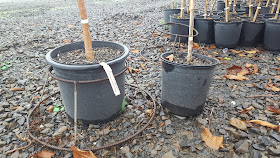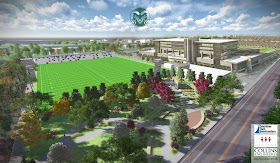I was fortunate to attend (and present at) the International Society of Arboriculture (ISA) annual meeting in Fort Worth, Texas in August. You may remember my blog from a couple years ago about research that was done by Hall and Ingram on estimating the carbon footprint of a nursery-grown tree. And I admit that I totally "nerd out" when nursery studies answer questions and solve problems for growers and those of us who buy their plants.
Mike Arnold from Texas A&M University and his fellow researchers Lauren Garcia-Chance, Geoffrey Denny, Sean Carver and Andrew King, recently published an article in the Journal of Arboriculture and Urban Forestry, which Dr. Arnold presented at the meeting in Texas:
"Differential Environments Influence Initial Transplant Establishment Among Tree Species Produced in Five Container Sizes": 42(3): 170-180. Since it's a new article, it's not available to the general public.
The objective of the research was to determine if production container size affects the establishment of different tree species when planted in the landscape. It's a question I get whenever presenting tree planting information: does the size of the tree (or container in which it is growing) matter for establishment and growth? The pros and cons to planting larger trees are:
 |
| Trees grown in black plastic containers often develop circling roots - which can turn into problematic girdling roots when the tree is planted in the landscape. |
- Larger plants create an "instant landscape"
- Quicker increase in property value due to larger, more mature trees
- More rapid development of shade
- Less potential for damage by people and animals
Cons
- For the buyer, more expensive than smaller trees
- For the nursery, more expensive to care for and they take up more space
- Greater potential for circling/girdling roots after planting in the landscape
- More difficult and expensive to transport and handle at the planting site
- Require a larger planting hole
- Greater potential for transplant shock
Property owners and landscape architects/designers must decide if the pros outweigh the cons. Often it comes down to the fact that many people don't want to wait several years for their landscape to look mature, so there is a big demand for larger trees - in spite of the potential problems they present.
 |
| Different size containers used in nursery production (compared to a soda can); image from lewisbamboo.com |
 |
| For the 3 tree species tested, the Texas A&M researchers found that smaller containerized trees caught up with larger trees within 3 years after planting in the landscape |
Dr. Arnold's presentation continued where the research paper left off...looking at the growth measurements three years after planting and the results were astounding. With the chaste tree, they found that trees planted from a #1 container caught up to those grown in the #45 container in just three years! Holy moly! And the bottom line was that trees planted from #3 and #7 containers recovered more quickly from transplanting and reached establishment sooner than the other sizes.
What this study proved is that, if you plant smaller (and less expensive) plant material and wait a few years, you will realize maximum economic gain and greater visual impact from the smaller plants - and they are less likely to have problems like circling or girdling roots when they are mature trees. But you may have to wait three years for them to catch up with the larger trees. Is the wait worth the benefits? Only you can make that decision!
 |
| Smaller container plants are less expensive for the consumer because nurseries don't have to care for them for as long as larger plants and they can move them from the nursery to the buyer sooner. |




















